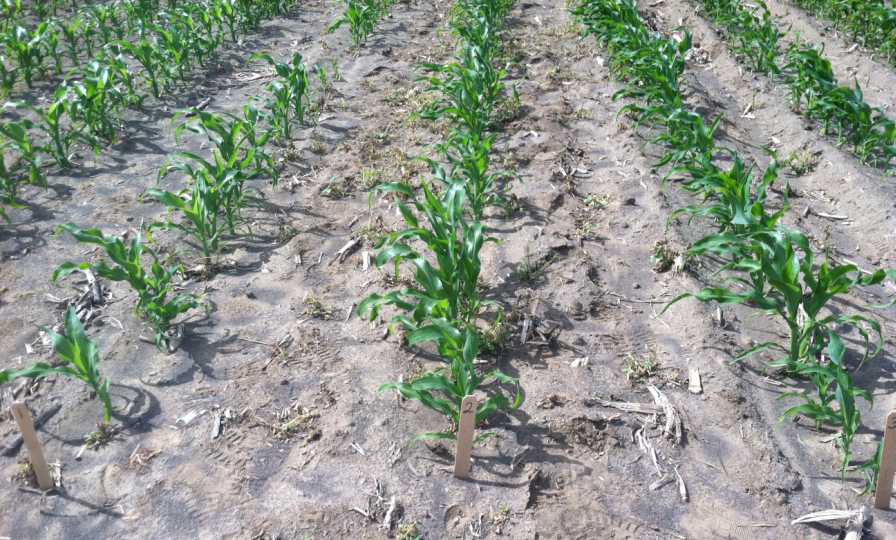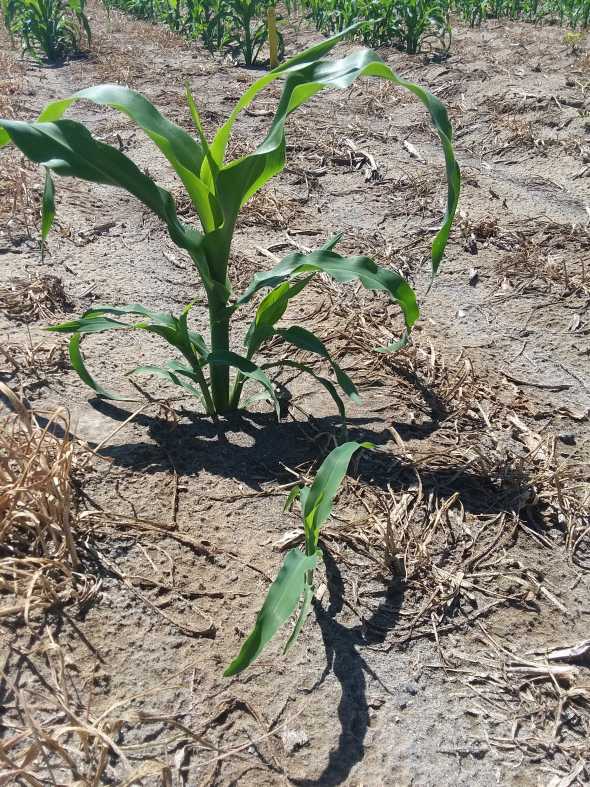What Have We Learned from 30 Years of Sweet Corn Seed Treatment Trials?

Seed treatments make a difference in sweet corn stands, especially for varieties like ‘Supersweet Jubilee’ that are highly susceptible to seed rot and seedling blights. The row on the left was planted with non-treated seed (53%). The rows in the middle (74%) and right (80%) were planted with seed that had been treated with standard fungicide blends. This is a typical result of the ISCDA Seed Treatment Trials and a clear endorsement for seed treatments.
Photo by Carrie Wohleb
Seed treatments are invaluable for sweet corn production, which explains why most commercial sweet corn seed is sold to growers with a treatment already applied.
Each year, researchers organize the The International Sweet Corn Development Association (ISCDA) Seed Treatment Trials planted and evaluated at sites across the country to find the best fungicide seed treatments for diverse planting environments and production systems.
Pythium-Targeting Seed Treatments
We have been evaluating some novel oomycete-targeting fungicides. These products are a priority because new evidence suggests metalaxyl and mefenoxam-resistant Pythium populations are more widespread in our soils than previously known. Some alternative products are needed. Syngenta’s new oomycete fungicide, Vayantis (picarbutrazox), has performed well in our trials and is expected to be registered for use on corn, pending EPA approval.
Organic Sweet Corn Seed Treatments
There has been increasing interest in biopesticides and microbial seed treatments, especially for organic sweet corn production where there are fewer options to control seed-borne and soilborne pathogens. We have included several of these products in our trials but have not observed consistent results across years or environments needed to promote their use. We continue to look at these products.
Organic sweet corn growers should consider the following to minimize seed losses:
• Select vigorous varieties that can better cope with pathogens.
• Pay attention to germination and vigor tests (cold germination tests) when buying seed; vigor tests are more informative because the seed is subjected to conditions more like those that can occur in the field.
• Incorporate plant residues well in advance of planting, because undecomposed residues can be a green bridge for soil pathogens to survive and develop on, and they can attract soil insect pests like seed corn maggots.
• Delay planting until soils are at least 60°F. That can vary depending on location. For example, we usually recommend 65°F in the Columbia Basin. But 60°F is more realistic for some other parts of the country that tend to be cooler.
• Consider using a higher seeding rate to make up for some seed loss from soil pests and pathogens.
Looking Ahead: Will Needed Fungicides Disappear?
Many of the seed treatments that were recommended based on results from the first ISCDA Seed Treatment Trials are no longer registered for use on sweet corn. We are concerned that more of these older fungicides will eventually be phased out or canceled when they are reviewed during the EPA’s pesticide re-registration process.

Weak plants tend to produce small ears or ears with delayed maturity that are not ready for picking when the crop is harvested.
Photo by Carrie Wohleb
Past Breakthrough Discoveries
Over the years, the ISCDA Seed Treatment Trials have demonstrated that the most effective seed treatments include the following components:
• Broad-spectrum, protectant fungicides like Captan, Thiram (Bayer Crop Science), or Maxim (Syngenta) are used to clean up the seed and provide some temporary protection from a diverse group of soil pathogens. These products have contact activity only (not systemic), so they have limited ability to protect the developing seedling.
• Systemic fungicides provide some continued protection to the seedling after germination. Dividend Extreme (Syngenta) or other products that include difenoconazole and other triazole fungicides are commonly used. Triazoles are broad-spectrum — at least for true fungi — but are mostly used to target Fusarium on sweet corn seed. Additional systemic products like Vitavax (Arysta LifeScience) or strobilurin fungicides like Dynasty (Syngenta) or Stamina (BASF) are often included to target Rhizoctonia.
• Seed treatments almost always include metalaxyl or mefenoxam — e.g., Allegiance (Bayer Crop Science), Apron (Syngenta) — to control Pythium. These are systemic fungicides that target oomycetes rather than true fungi. Oomycetes are quite different from true fungi and are not usually controlled by the same products.
• Insecticides like Cruiser (Syngenta), Gaucho (Bayer Crop Science), or Poncho (BASF) are included in some seed treatment blends to control wireworms and seed corn maggots when needed.
How the Annual Trials Work
The ISCDA Seed Treatment Committee organizes an annual trial to identify seed treatments to improve sweet corn stands across diverse environments.
The committee selects treatments, applies them to sweet corn seed, and sends them to researchers across the country to plant and evaluate.
Treatments are evaluated for effects on stand, weak plants, and seedling vigor. Results from each location are compiled and summarized then shared with committee members and their colleagues. The results are used by seed treatment companies to evaluate and market their products, and by sweet corn seed companies to help them select treatments to apply to the seeds they distribute to growers across the country.
The first trial was conducted in 1989. Why do we conduct the ISCDA Seed Treatment Trials after 30 years? Stand establishment can still be a problem for sweet corn, especially for early plantings where cold soils can delay germination and increase the time the seed is exposed to soilborne pathogens.
Interested in Participating in the Research?
The ISCDA Seed Treatment Committee is open to all sweet corn enthusiasts and is usually made up of representatives from sweet corn seed companies, seed treatment companies, and researchers from public universities. Currently, most participating researchers are in the Pacific Northwest and Midwest. We welcome new participants from all regions but need to collaborate with more public and private researchers in the East and South. If you are interested in participating, please contact me at [email protected].










